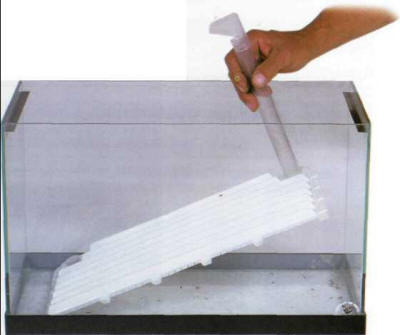HOW TO PROCEED
The steps to be taken when setting up an aquarium have a logical order, and this
must be respected. These steps vary slightly according to whether fresh water or
sea water is being used, but the underlying principle is the same: water is not
poured into the aquarium until the decor, bed, and the necessary technical equipment
are in place.
Installation, step by step The order is as follows:
- Cleaning the tank. Use a brand new sponge and warm water. It is best to
avoid detergents.
- Fitting the external decor. Make sure that this is put firmly in place,
otherwise it will be difficult to fix later on.
- Mounting the aquarium on its support. Remember that the support must be
absolutely horizontal and covered with a flexible material that will compensate
for any possible unevenness. At this stage, make sure that you leave sufficient
space behind the tank to allow you easily to open the gallery and the entrance
that gives access to the pipes and cables. The aquarium will not be moved again
after this point.
- Fill the tank, to make sure it is watertight. Leaks are rare occurrences;
a slight seepage is more common, although this can only be detected about 24
hours after putting in the water. When you are sure your aquarium is watertight,
siphon out the water.
- If you are using an under-gravel filter, position it so that the air-lift
is in one of the tank's rear corners.
- Installing the accessories. Place these directly into the tank or in the
boxes of the box filter. The heating system must not come into direct contact
with any plastic elements, and it must be near the diffuser. If you are using
an external filter, do not forget the connecting pipes.
- Putting the decor in place. Introduce the rocks or corals, taking into account
both the visual and practical aspects and making sure to hide the accessories.
Take your time and experiment until you are happy with the overall aesthetic
effect. Once you have filled the aquarium, you are unlikely to get another chance
to make adjustments to the decor
- Putting in the bed. Half the sediment is placed directly on the bottom of
the tank, without any prior washing. The second half is rinsed in warm water
until the latter is transparent. It is then put on top of the first layer. Make
sure that the elements of the decor are firmly wedged into the bed. Some of
them can be used to create raised sandy terraces at this point. For aesthetic
reasons, the sediment should slope downwards slightly from the back to the front
of the aquarium: this gives the impression of a greater depth of field.
- Filling the tank. Whatever method you use - a pipe connected to a faucet
or buckets - break the fall of the water to avoid dislodging part of the sediment.
The time-honored trick is to pour the water into a bowl or concave plate. The
aquarium must not be filled to its maximum height, as you may need to make corrections
in the decor if, for example, a piece of wood starts to float. You can also
put in your plants now. The water will be slightly cloudy, with microparticles
on the surface that can be eliminated with a very fine-meshed landing net, or
through siphoning.
- Switching on the equipment. First check that the heating element is totally
submerged, then turn on the heating and regulate the temperature to 25°C. Plug
the aeration and filtration systems into the mains. A quick glance will be enough
to check that everything is working and after a few hours the water should have
heated up and be clearer.
- Wait for another 24 hours, then recheck that the equipment is working. The
water must now be clear, with a temperature around 25°C. It is sometimes necessary
to make slight adjustments to the regulation of the thermostat to obtain the
desired temperature. You can now add any other vegetation.

Putting the under-gravel filter in place, ready to receive
the sediment. The water exit must be positioned in one of the aquarium's rear corners.

The sediment covers the undergravel filter, and the heating
and aeration equipment must be camouflaged.

A tank must be filled with care, to avoid knocking over any decor.
Operations specific to marine aquariums.
The process is identical up to stage 6. This is when you must install the aerator
and the UV sterilization system.
Put the decor in place and then add the bed. The latter must all be washed beforehand
and then placed on a thin layer of sediment. After that, fill the aquarium with
the freshest water possible; only switch on the aeration. Now is the time to dissolve
the salts. Weigh the amount you require, on the basis of the real volume of the
water, before putting them into the aquarium. Leave the salts to dissolve for 48
hours, check the density, and make the necessary adjustments. Then move to stage
10, without switching on the aerator or UV system.

The vegetation can be planted by hand, or with specially
designed pincers.
|